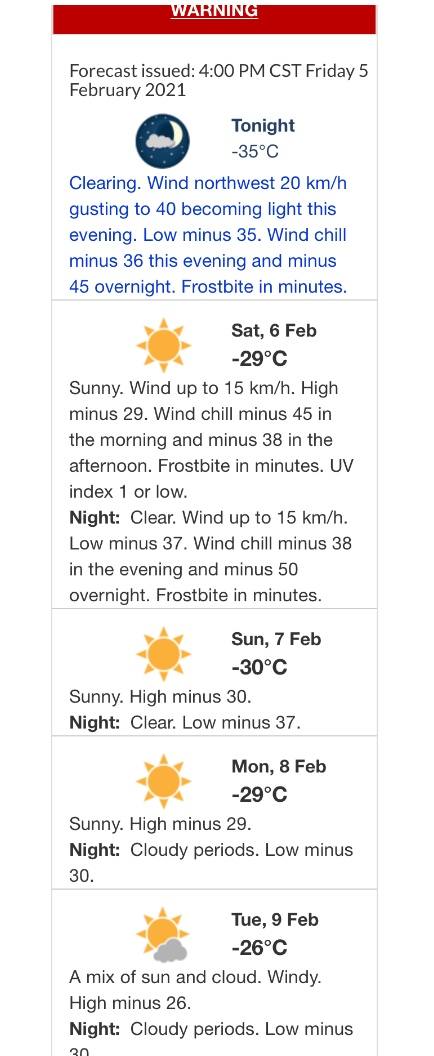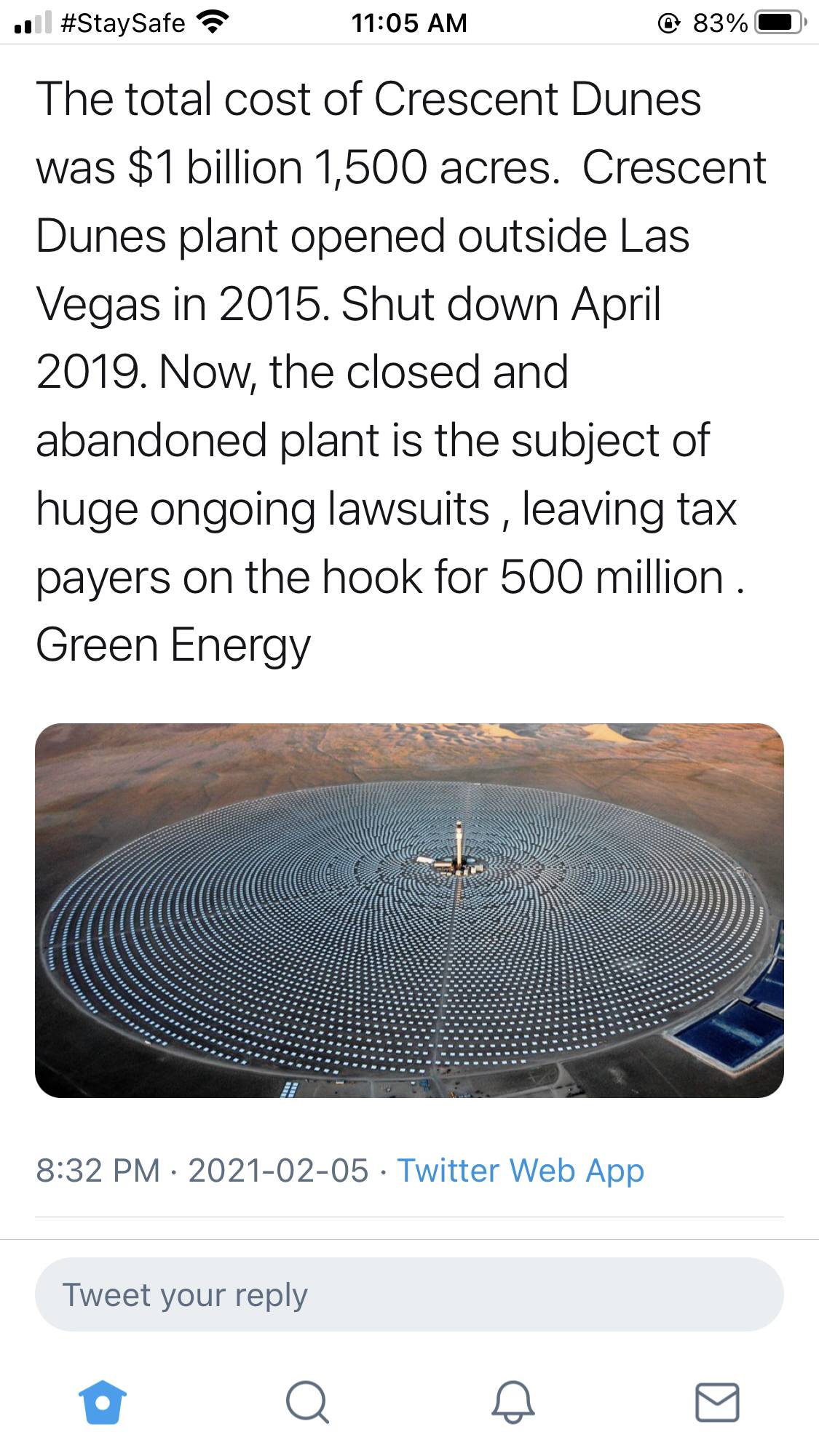Originally posted by AlbertaFarmer5
View Post
Announcement
Collapse
No announcement yet.
World's biggest battery with 1,200MW capacity set to be built in NSW Hunter Valley
Collapse
Logging in...
Welcome to Agriville! You need to login to post messages in the Agriville chat forums. Please login below.
X
-
Very curious Chuck2 why you think that in western Canada we are interested in this article. For the last 3 days according to the AESO the Brooks solar farm hasn’t produced a watt, there must be snow on the panels. As I look this morning, it is -26 and the wind turbines must have decided to take the weekend off as they are only producing 42 megawatts out of a potential 1781. So please explain to me how the batteries would get charged in the first place and then how long you think they will keep us from freezing to death at -26?!Originally posted by chuckChuck View PostWorld's biggest battery with 1,200MW capacity set to be built in NSW Hunter Valley
The announcement by CEP Energy is the latest in a flurry of major energy storage projects for Australia’s national electricity grid
Adam Morton Environment editor
@adamlmorton
Fri 5 Feb 2021 04.18 GMT
Developers plan to build what they say will be the world’s biggest large-scale battery in the New South Wales Hunter Valley, the latest in a flurry of major energy storage projects announced for the national electricity grid.
CEP Energy said its $2.4bn battery at Kurri Kurri, north-west of Newcastle, would have a power capacity of up to 1,200 megawatts – about eight times greater than the battery at Hornsdale in South Australia, which was the biggest when it began operating in 2017.
It would also be significantly bigger than large batteries announced in the past three months for the Lake Macquarie Eraring coal power station in NSW, the Wallerawang power station near Lithgow, Torrens Island in Adelaide and near Geelong in Victoria.
CEP Energy said it was part of a planned network of four grid-scale batteries, including two in Victoria and one in South Australia, that would have a combined capacity of 2,000MW. It was also planning 1,500MW of rooftop solar panels on industrial sites.
Morris Iemma, a former NSW premier and CEP Energy’s chairman, said the clean energy roadmap that passed the state’s parliament last year had given the market confidence to invest in renewable generation supported by large-battery storage without subsidies.
He said big batteries would play a major role in filling the gap left by the retirement of coal and gas plants, including the closure of the Liddell power station in early 2023.
“This project will help ensure the Hunter region of NSW remains true to its heritage as one of the nation’s energy powerhouses as we work towards a cleaner, decarbonised future,†Iemma said.
BirdLife Australia said it was concerned about plans to expand industry in endangered bird habitat in the Tomalpin Woodlands near Kurri Kurri. It said the battery was one of a number of projects that could affect the woodlands, which is one of the few remaining regular breeding areas for two critically endangered species, the regent honeyeater and swift parrot.
The group’s woodland birds project manager, Mick Roderick, said the battery had not been properly thought through. “Renewable energy is great and there are potentially appropriate sites nearby, but this proposal cannot be built in the Tomalpin woodlands,’†he said.
If it goes ahead at the scale planned, the project could challenge the viability of gas-fired power plants proposed for the region by AGL Energy and EnergyAustralia. It would also raise further questions about a Morrison government proposal to instruct the taxpayer-owned Snowy Hydro to build a gas plant at Kurri Kurri if companies have not made commitments by April to directly replace Liddell.
The government has said NSW will need 1,000MW of new flexible electricity capacity that can be called on at any time to support variable solar and wind when Liddell shuts, but the suggestion more gas-fired power is needed in the region to ensure grid stability and keep prices down is contested.
The Australian Energy Market Operator (Aemo) found only an additional 154MW would be needed in NSW by 2023 to meet the electricity grid’s strict “reliability standardâ€, and that well in excess of that amount had already been announced. Origin Energy, AGL Energy and Maoneng have all recently announced battery projects in the state.
CEP Energy says construction of its big battery is planned to start in early 2022, with operation to begin the following year. It will be built in the Hunter economic zone, one of five renewable energy zones announced by the NSW government.
The company is yet to decide the storage capacity, which will determine how many hours it can run.
Battery technology has taken off more rapidly than was predicted. An Aemo forecast in 2016 suggested the country might have only 4MW of large-scale batteries by 2020, and build no more than that before 2036.
A report in November said the country already had 287MW in operation or committed to construction. Plans for more than 2 gigawatts have been announced since then.
Aemo has suggested the grid will need between 6GW and 19GW of new flexible electricity capacity over the next two decades as old coal-fired plants close and are mostly replaced by solar and wind.
Flexible capacity can come from batteries, pumped hydro, demand management programs and gas. Aemo last year found additional gas-fired power, which is the only fossil fuel on the list, was an option, but not essential as part of an optimal future grid and was likely to be more expensive than alternatives.
Comment
-
No need to rehash our arguments for and against renewables.
Just posted the article to show whats happening in Australia that is pushing hard on more renewables. Even Mallee was looking at solar.
I didn't say that storage on this scale was a good option for Alberta did I?
The AESO did a study on storage and basically said storage is not economic nor needed in their current plan to 2030. The AESO plan is to use gas and all the various generation sources in a plan to reduce carbon emissions and phase out coal. If you want I can post the link again.
If you want the details of how this will work contact the AESO.
Comment
-
The big problem is costs to heat our homes and work places are going to continue to escalate due to carbon tax’s to a point where what are people going to do in winter here in Canada before there is a viable green alternative for 5 months of the year ? Who in rural areas will get carbon tax rebates to offset this huge increase in energy bills ?
That’s the gap in time that’s being ignored while touting all the great solar inventions that work in mid latitude countries with year around good solar productivity and almost never see temps below freezing.
Good for them I say , but what’s going to happen here , $250 -$300 / tn carbon tax with no viable alternative for many to heat homes with limited wind or solar when -35 to -45 ?

They are going to drain any disposable income left from many well before alternative energy sources are readily and economically available.
Anyone on here have an electric vehicle ?
Just curious as to how they perform over this next week. Is the interior heating enough when below -20 ?
I have no idea , just curious
Comment
-
Some observations:
Battery backup can most profitably be used to replace peak loads.
Batteries must be kept charged for use at all costs.
Batteries will often be charged at off peak times.
This may require that carbon based fuels will be used to provide the charge.
Comment
-
I'm puzzled as to why Chuck would keep posting these articles about the expensive attempted patches Australia or others are trying to use to stabilize the grids they purposefully destroyed.
They certainly don't help his cause.
Why advertise that the biggest battery in the world is so inconsequential it can only at best keep the grid from crashing long enough to get the consumers to reduce their loads? This isn't remotely large enough to sustain demand.
Chuck posts article after article gloating about the billions of dollars being spent to try to salvage the billions already spent by putting more patches on. Then goes on to tell us how renewables are the cheapest generation source, while ignoring all of the consequential costs, which he so generously points out.
Difficult at times to figure out whose side he is on. Understandable why dml and others have stopped coming to his rescue when he digs himself a hole.
Comment
-
Hamloc, the $3.5 trillion may prove to have been much too low. As it turns out, a week long wind drought is not unusual. I've been watching the Kettle Hills wind farm(at 0MW again this morning). Now down to 15% capacity factor over a 17 day period, in spite of a powerful Chinook in the middle of that. I thought that must be the exception, so I checked back using the same lenght of time. 2 years ago at this time the capacity factor was down to 5% over 17 days. Has been multiple events where it went down to 10%or 7% for 17 days. So looks like we need to budget for 2 or even 3 weeks of storage in a zero carbon economy. That is getting into the 10's of Trillions just for Alberta.
But on the bright side, Chuck keeps claiming that storage costs are dropping, becoming competitive, imagine how much it would have cost otherwise.
And there is where the problem lies. Naive people unable to do math read an uninformed headline such as this one. Repeat it and spread it. When you see that often enough, it is easy to believe that grid scale storage really is viable and scalable and economical. We have politicians buying into this, unable to do even basic math.Last edited by AlbertaFarmer5; Feb 6, 2021, 11:02.
Comment
-
-
 Guest
Guest -
Nope all that green shit is wast of money and no one gives a shit for some reason. Doesn't help climate one iota!
Comment
- Reply to this Thread
- Return to Topic List

Comment